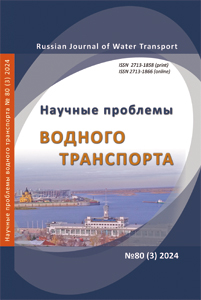Estimation of power consumption of the main engine of a seaworthy vehicle on air-supported tracks
Abstract
The comprehensive development of the Far Eastern and Arctic coasts of Russia requires the development of all types of transport. One of the promising types is seaworthy vehicles on air-supported tracks. This type of transport has a minimal impact on the tundra soil, which is easily destroyed in the summer. The load-bearing capacity of this type of seaworthy all-terrain vehicles can reach 150 tons. The design of the air-supported tracks includes a high-strength endless elastic belt with low-pressure pneumatic tiles mounted on the outer surface. An air cushion is used instead of a mechanical suspension system. The use of low-pressure pneumatic tiles provides a large area of the "contact patch" with the soil, which allows moving along its surface without damaging the tundra turf. An important task in developing this type of transport is the design of the power plant. The results of serial full-scale experiments and analytical dependencies were used to estimate the required power of the power plant. This article is about to mathematical modeling and the results of determining power consumption during the co-directed movement of water and the caterpillar surface in contact with it.
References
Азовцев А.И., Москаленко О.В. Крупномасштабная модель для исследования мореходности вездехода на воздухоопорных гусеницах // Транспортное дело России. 2015. №6. URL: https://cyberleninka.ru/ article/n/krupnomasshtabnaya-model-dlya-issledovaniya-morehodnosti-vezdehoda-na-vozduhoopornyh-gusenitsah (дата обращения: 28.04.2024).
Азовцев А.И., Огай С.А., Москаленко О.В. Метод DTNSRDC в прогнозировании мощности мореходного вездехода на воздухоопрных гусеницах грузоподъемностью 100 тонн на начальных стадиях проектирования/ Морские интеллектуальные технологии 3(37) Т.2 2017 C.88-92.
Азовцев А.И. Особенности и проблематика проектирования мореходных транспортных средств на воздухоопорных гусеницах: диссертация доктора технических наук : 05.08.03. - Владивосток, 1995.
Азовцев А.И., Огай С.А., Москаленко О.В. Прорыв в области внедорожного амфибийного транспорта // Наука и транспорт. Морской и речной транспорт. Транспорт Российской Федерации. 2011. С. 48-50.
Wilson R.A., Wales S.M., Khober Ch.E. The determining of power of hovercraft based on model test results (DTNSRDC). David W. Taylor Naval ship research and development center. USA.5. Bunch J. Rose D (Eds.) Sparse matrix computations. – New York – San Francisco –London: Academik Press. 1976.
А.И. Азовцев, С.А. Огай, М.В. Войлошников, В.А. Петров, О.В. Москаленко. Амфибийные вездеходы на воздухоопорных гусеницах для освоения арктических шельфовых побережий. Морские интеллектуальные технологии, № 1, том 2, 2020 С. 33-43.
Азовцев А.И., Войлошников М.В. Амфибийный транспорт для реализации стратегии развития арктической зоны российской федерации и обеспечения национальной безопасности на период до 2020 года/ Транспортное дело России. 2015. № 6. С. 245-246.
Азовцев А.И., Огай С.А., Карпушин И.С. Мореходные вездеходы для комплексного освоения шельфа и побережья стран АТР/ Asia-Pacific Journal of Marine Science & Education. 2012. Т. 2. № 1. С. 47-52.
Азовцев А.И., Огай С.А., Карпушин И.С. Облик мореходного вездехода на воздухоопорных гусеницах ограниченной грузоподъемности для арктического побережья/ Морские интеллектуальные технологии. 2022. № 4-1 (58). С. 46-51.
Азовцев А.И., Кулеш В.А., Огай А.С., Петров В.А. Развитие судов для условий грузовых операций на необорудованных берегах арктических и субарктических морей, Полярная механика. 2016. № 3. С. 450-460.
Copyright (c) 2024 Russian Journal of Water Transport

This work is licensed under a Creative Commons Attribution 4.0 International License.













